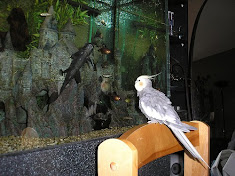 |
| Baby Geckos by Ronnie Tucker |
One of the first skills you have to learn is how to determine the sex of your pet. The basic difference between the male and the female is the hemipenal bulge that exists only in males. This can be found on the underside of the animal near the tail just after the vent. You might also notice a 'V' shaped row of pores somewhere near the bulge. These are the male anal pores that should be very noticeable.
When you are new to sexing these animals, you might get confused by some strange but very possible female characteristics. Females also have pores in their hind side but they are not as noticeable as the males. Leos also naturally store fat in their tails. This fat can sometimes cause the tail to bulge up and can be mistaken as a hemipenal bulge in females. Be wary of these situations. If in doubt, try to ask a reliable breeder for confirmation.
Facts on Selective Breeding
The process of selective breeding can be one of the hardest to master. There are sometimes so many traits to keep track of that it ends up being a 'learn as you do' thing. Experience is invaluable but there are some things that you can know outright. One of them is the difference between recessive traits and dominant traits.
Dominant traits are the obvious traits that you can see. When you say that a trait is dominant, it is the trait that will appear should the leo inherit two 'genes' that determine a single trait (for example, should the lizard inherit a dominant trait like orange coloring versus a recessive trait of a different color, the orange will be the one visible even though the lizard has the genes for both traits).
Some common dominant traits would include the orange coloring for tangerines and hypos, the carrot tails, and the giants. Some common recessive traits would include albinism, the patternless morph, and blizzards.
Mating Facts
The mating process in leopard gecko reproduction can be quite violent at times. Males will often become aggressive towards females during the process. This is when you should be most careful. If your female does not accept the male's advances, she will start to fight back and you may end up with a lot of fighting resulting in injuries. If this happens when you attempt to mate your lizards, separate them at least for a few days. Try again once things have cooled down a bit.
Egg Facts
One of the cooler things you can do with leos is to control the sex of the next generation of lizards. You can use differing incubation temperatures to change the sex of the lizards while they are in their eggs. If you keep the temp at 79 to 84 degrees (right about the temp of the cool area of a tank), then you'll get females. If you keep the temp at around 86 to 90 degrees (about the temp of the warm area of the tank), then you'll get males.
Author Resource: Written by Donna Perez
Donna Perez is a lizard enthusiast who has vast experience of raising Leopard Geckos. For more information about Leopard Gecko Reproduction, Visit Leopard Gecko Heaven.



0 comments:
Post a Comment